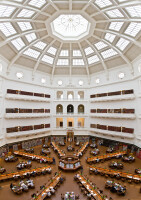ROBIUL ISLAM Review of State Library of Victoria, Mel...
In 1853, the decision to build a combined library,...
In 1853, the decision to build a combined library, museum and gallery was made at the instigation of Lieutenant-Governor Charles La Trobe and Mr Justice Redmond Barry, Q.C. (Sir Redmond from 1860). A competition was held, won by the recently arrived architect Joseph Reed, whose firm and its successors went on to design most of the later extensions, as well as numerous 19th-century landmarks such as the Melbourne Town Hall, and the Royal Exhibition Building.
On 3 July 1854, the recently inaugurated Governor Sir Charles Hotham laid the foundation stone of both the new library complex and the University of Melbourne. The library was the first stage opened in 1856, with a collection of 3,800 books chosen by Mr Justice Barry, the President of Trustees. Augustus H. Tulk, the first librarian, was appointed three months after the opening. The Melbourne Public Library as it was then known was one of the first free public libraries in the world, open to anyone over 14 years of age, so long as they had clean hands.
The complex of buildings that now house the Library were built in numerous stages, housing various library spaces, art galleries and museum displays, finally filling the entire block in 1992.
The first stage was the centre of the front block, opened in 1856, with most of the front wing, along with the floor Queen's Reading Room (now Queen's Hall) complete in 1864 by Abraham Linacre.Other wings were built are various time, such as Barry Hall, along Little Lonsdale Street, in 1886, McCoy Hall (now the Redmond Barry reading boom), built for the Museum in 1892, Baldwin Spencer Hall facing Russell Street in 1909, and the McAllan Gallery on the LaTrobe Street side, built in 1932.
Temporary buildings were built in 1866 for the Intercolonial Exhibition of Australasia just behind the front wing, which remained in use until 1909, when work began on the library's famed Domed Reading Room, opened in 1913, designed by Bates, Peebles and Smart, the successor to Reed's firm, now known as Bates Smart.[8] In 1959, the dome's skylights were covered in copper sheets due to water leakage, creating the dim atmosphere that characterised the Library for decades.

Comments: